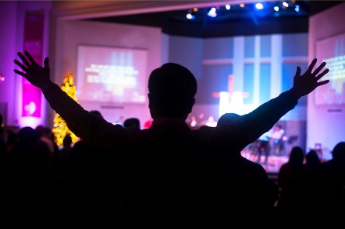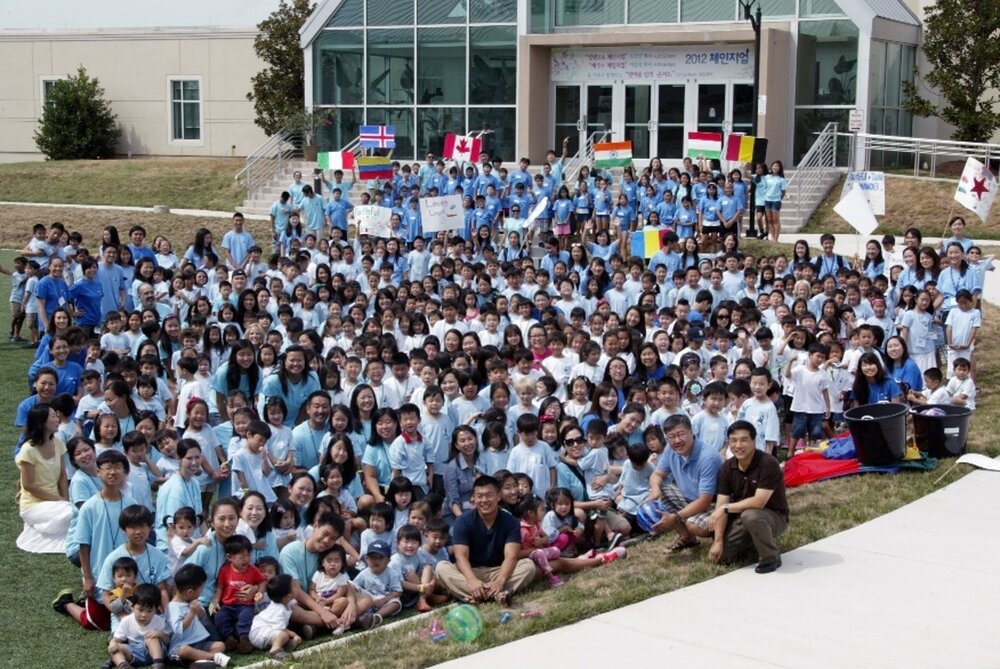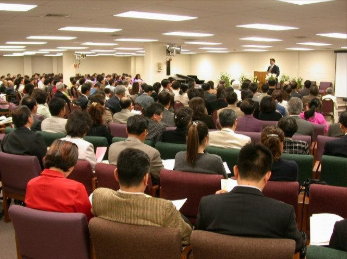What would it look like for an immigrant church and a second-generation church to exist side-by-side as equal partners? Although this might sound like a pipe dream, it’s a reality for Open Door Presbyterian Church in Herndon, Virginia.
Open Door Presbyterian Church has an interdependent and intergenerational model, in which there is the Korean-speaking Congregation (KC) and the English-speaking Congregation (EC) that may have separate groups and processes but share responsibilities and ministries. The church was originally founded in 1984 as an immigrant church. But as the children of those immigrants grew up, the church found a need to create an English ministry for college students and young professionals.
One of the people who has been through the many changes of the church is John Cha, the current senior pastor of the English-speaking congregation. He attended the church since he was 6 years old, and after graduating college, he worked full-time as a finance analyst and part-time as a teaching pastor. Then Cha felt the call to be a full-time pastor, and in 1998, Cha became the third EC pastor, and he has been in that role for more than 20 years.
Through a series of emails, Pastor Cha and I discussed the story of Open Door Presbyterian Church and the unique model it presents to the Asian American community and the world. His enthusiasm and love for his church, both the English-speaking and Korean-speaking are clear throughout our conversation.
SOLA: What was Open Door’s English-speaking congregation like before you particularized (became distinct) as an organization? What was the relationship like with the Korean-speaking congregation?
John Cha: In the 1980s our church’s English ministry emerged and grew from our youth and college group under our 1st-generation Korean congregation. In the early 1990s, when we became young adults and professionals, under the leadership of our senior pastor, Pastor Paul Kim (a bilingual, 1.5 generation pastor of our Korean congregation), we decided to pursue an “interdependent model” of growing together with our Korean congregation to eventually become an English-speaking congregation partnering side by side with our Korean-speaking congregation. And in 1995, to give ourselves a clearer sense of identity and distinction, we named our EM “Cornerstone Ministry.”
At this point, our EM was a mid-sized congregation of 130, with most members in our mid-to-late 20s. Because we were located near Washington, DC, more transplants from other cities and states started attending our congregation.
Throughout the decades of evolution and growth of our leadership, we were always graciously invited by our KM elders to a monthly gathering, and we also attended an annual retreat with them to build relationships and to revisit and recommit to our vision of interdependence. Almost all our meetings surrounded a wonderful meal, catching up on personal and ministry matters, and planning ahead on 1-2 points of collaboration altogether.
Financially, in our early years, our EM budget (submitted and managed by us) was under the overall governance and supervision of our elders (all of whom were KM), but we received every budgeted item — and more when financial needs arose.
What was your relationship with Pastor Paul and the Korean congregation like?
At the onset of our interdependent journey, our entire pastoral staff was small, with 5 of us total. We enjoyed our season as a smaller staff, where our KM, EM, youth, and children’s pastors ate lunch together almost every day. We shared life, shared even our food, and sometimes talked about ways that we can work together on various church-wide efforts.
Pastor Paul extended an open door policy to all of us. In many ways, he set the tone of graciousness, partnership, and collaboration — which then spilled over to all our other staff — which in turn spilled over to all our lay leaders and members.
What were some of the challenges, seen and unforeseen, during the process of particularizing?
The first was the challenge of holding on to unhealthy narratives. Early on, whenever we encountered minor differences and conflicts between our EM and KM, those who were critical of interdependence suspected the worst in the other. People made assumptions and conclusions that were inaccurate and scornful of the other. Much of these came from unhealthy narratives. Some of our EM members came to us from other Korean immigrant churches with painful stories of church dissension and splits involving the KM. As a result, sometimes, stereotypes and caricatures were unfairly projected on our KM.
The second was the differences between cultures and generations. Our KM’s approach was hierarchical/top-down, commitment-driven, and they seized every opportunity as a bold act of faith. They moved at 100 mph and pivoted on a dime, often at Pastor Paul’s direction. On the other hand, our EM moved slowly. We were driven by process and consensus. We valued long-term strategy and ministry alignment. We moved at 50 mph. The KM would look at us … “Where’s your faith and commitment?” We would look at our KM … “Where’s the long-term buy-in of all your members?” Thankfully, throughout our 30 years together, they rubbed off a little more on us, and we rubbed off on them.
Third was the painful cost of being a “bridge.” Our KM and EM leadership helped to build connections between our two congregations. Pastor Paul and I often functioned as bridges. We made sacrifices and compromises for the sake of the other — while still trying to shepherd our own respective congregations. There were times when we were misunderstood. If I advocated for our EM, our KM leadership thought I was favoring just our people. Then at times, I would support our KM leadership, and our EM leadership would think I was advocating too much for our KM. It felt like I was stepped on from both sides. But that’s the sole function of bridges — to be stepped on as they bridge two divides.
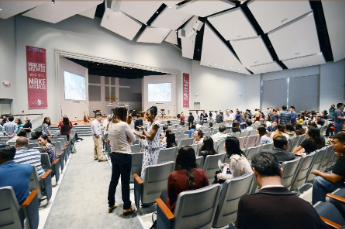
Fourth was moving to Herndon. In 2000, we purchased a 13-acre property together in Herndon, VA. Both our KM and EM were financially committed toward this $7M purchase together. It meant that our model of interdependence was no longer just theory, or just on paper, or occasional. We all gave beyond our comfort-zone. We prayed fervently for God to provide and guide us through our church building campaign. Moreover, looking ahead, we would now be on the same campus and in the same building. Unfortunately, after we voted to purchase this property together with our KM, our EM lost about 17 families/household. But strangely, after our move, we grew the most as a church. Around this time, our EM was now at 300 members.
Finally, we didn’t have a mature model of interdependence: When it came to interdependence in the immigrant context, we couldn’t find a church that was 10 steps ahead of us. And so, when our own people asked us what this model is supposed to look like in detail, we just kept telling them to wait on God, to walk by faith one step at a time together, and let’s see. We said this for 20 years! It wasn’t until the last 10 years where people were starting to see more tangibly how interdependence looks and feels.
What is the relationship like now?
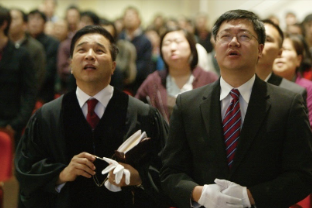
We call it 1:2:1 which is shorthand for 1 vision, 2 households, 1 family. Together we agreed on this definition of interdependence as a church. We are a church that comes together for 1 vision, that is practiced in our own respective contexts as 2 households, but relationally, we remain 1 family. It’s a helpful definition for many of us because we experience this in our own personal homes every day. Many of us live apart from our parents (hence 2 households), but we still gather around united goals (1 vision) and regular meals/outings as a family (1 family).
Functionally, if you had to draw our church structure on paper, we have 3 columns. There is a column on the left labeled “KC” (Korean-speaking Congregation), a column on the right labeled “EC” (English-speaking Congregation), and a column in between labeled “ID/IG” (interdependent/intergenerational) where we join together in partnership and collaboration.
In the KC column and our EC column are our own budgets, own buildings, own staff, own small groups, and most of our ministries. But in the middle ID/IG column are some of our key missions efforts, our children’s and youth education, a few other ministries, and joint efforts of our staff and elders. In this column, we only designated ministries where it just “made sense” for everyone to collaborate together. We all knew we could go further together with these ministries than on our own.
Our staff and elders meet together frequently as well. Our KC and EC staff meet every Tuesday to eat lunch together and collaborate on joint ministry efforts. Every spring, all our EC and KC staff go on a 3-day retreat together — solely to touch base personally and to build relationship.
Our elders also go on a retreat together to build community together. In the past 10 years, our KC and EC elders have also created subcommittees where 1 KC elder and 1 EC elder served together to govern over joint/church-wide ministry spheres (e.g., missions, Christian Education, finances/HR, campus ops, etc.). When decisions had to be made within these ministry spheres, the 2 elders worked together to bring the best proposal to our joint board. And so, we always received a unified, well-prepared proposal, represented by both a KC and EC elder.
In terms of finances, our EC and KC have our own separate budgets, but we also have a “shared” ID/IG budget, where we give towards shared costs (e.g., shared utilities, Christian Education, certain joint missions efforts, etc.)
Finally, we serve actively together on certain key ministry efforts and opportunities throughout the year, and we also gather and worship altogether on Good Friday, Christmas Eve, New Year’s Eve, baptisms, and during mission team send-offs. We are always encouraged and energized when we see God’s people serve together and when we worship our God whose glory extends from one generation to the next.
Is immigration in the area continuing to grow the Korean congregation? Or do you foresee the Korean ministry growing smaller?
Our KC is not growing smaller. Instead, they are steadily increasing in number. We have quite a few Korean-speaking families who still move into the area from other cities. Also, some of our EC members are having their parents move into the area so that our members can take care of them. These elderly Korean-speaking parents join our KC. Our KC is also growing by reaching out to unchurched Korean-speaking younger generations and also to bilingual Korean/English-speaking couples in inter-racial marriages.
What are some of the interdependent programs you have?
We are interdependent in our Christian Education where our directors and teachers work together. After Pre-K, all of our children and youth ministries from our KC and EC are combined. From the beginning, we decided that all our curriculum and messages will be done in English. All our directors/pastors are English-speaking, and all our volunteers/teachers are half KC and half EC members. All our PTAs are joint with translators on both sides to help make sure that communication and emails are sent in both languages.
In our missions efforts, we send joint teams consisting of members from both our KC and EC and sometimes, our YG as well. Many of these teams are medical or focus on children’s ministries. It’s beautiful to see all the different generations showing and sharing the Gospel together in their love for one another.
Locally, we host two large events together. One is the Fall Festival, which takes place on the Saturday before Halloween, that we host for our Herndon neighborhood. Last year, we had 300 of our volunteers help welcome 3500 of our neighbors with the radical love and hospitality of Jesus Christ. This year, we had 500 volunteers (from KC, EC, and YG) welcome 7,000 of our neighbors. 1,400 of our neighbors heard the Gospel through our event.
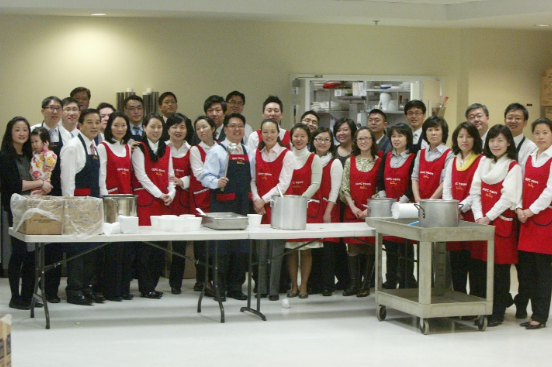
The other is our Hypothermia Clinic. Every March we host our homeless neighbors through partnership with our local county. Our EC provides the space, activities, security, worship/prayer ministry for our guests. Our KC provides delicious, 4-star meals, hair salon services, and manicures. Our youth help with set up and breakdown of the event.
Do you have any stories about families who have members in both congregations? How does the church support them?
We have the Kim family, three generations of whom attend our church. Their elderly grandmother who has been very active on our KC side has had to recently undergo multiple surgeries. Our KC side is diligently caring for her and visiting her. Her friends in her small group are daily praying for her and encouraging her. Her son and daughter in law, in our EC, are actively involved in our Christian Education and Finance Team. They also are supported (especially during this time caring for ill elderly parents) by their small group. Their children are in our older elementary ministries where they are learning and growing in the Gospel.
We also have a missionary family on the field who are members of our EC and whose parents are in our KC. Both our KC and EC formally support them and send joint teams to them, but we also support them by providing other personal family needs (e.g., clothes, books, musical instruments or learning devices for the kids, shipping Korean food, etc.) Now, one of their children will soon enter college and will join our EC college group. Together, our EC and KC have been supporting that family for over 20 years.
On a given Sunday morning, we have many of our EC families in their minivans drive over to our Student Ministry Center to drop off their youth group kids. Then they drop off their elderly parents at our KC main building, and then they park and walk into our EC worship center. It’s beautiful to see three generations gathering as one church, worshiping our God whose glory is to be declared from one generation to the next!
